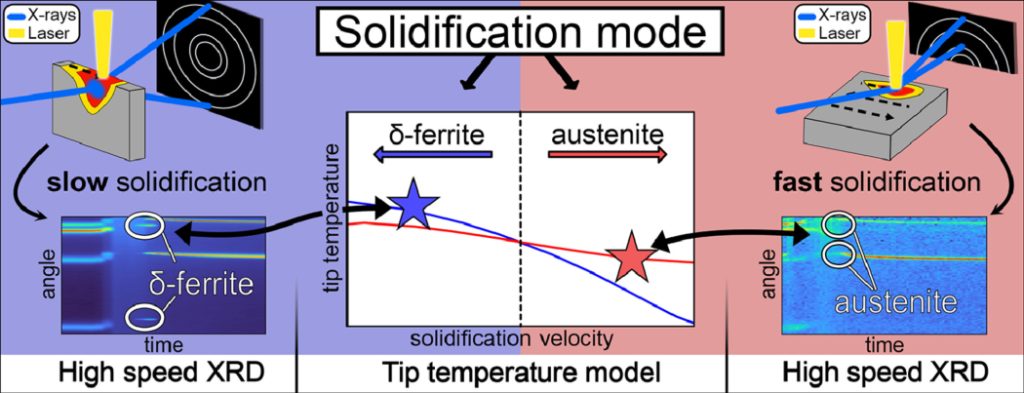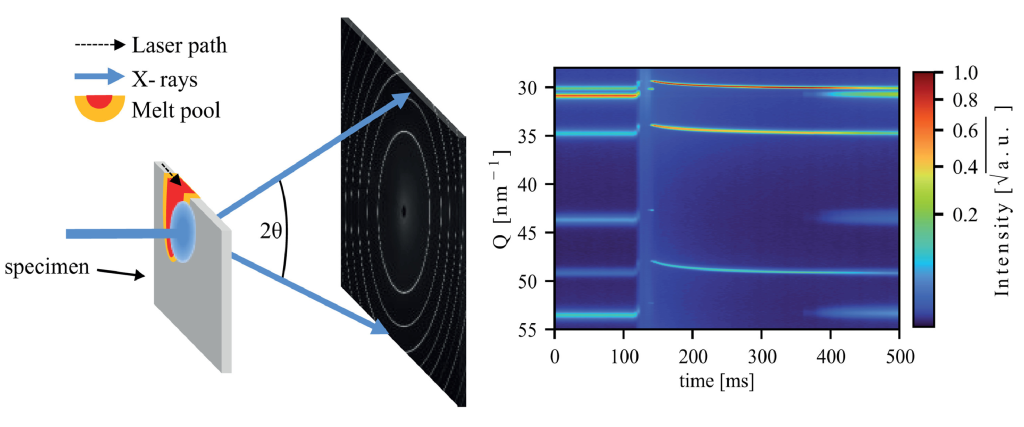A team of researchers from multiple institutions, including the National Institute of Standards and Technology (NIST) and KTH Royal Institute of Technology in Sweden, have announced a breakthrough in the understanding of how cooling rates affect metal properties during the laser powder bed fusion (LPBF) process.
LBPF, a popular method for metal 3D printing, uses a laser beam to heat a bed of powder material to create a small pool of molten metal. This melt pool then cools, creating a layer of printed metal. As this process repeats, these layers build up to form the completed 3D printed component. When printing with metal alloys, as the material heats up and cools off, its atoms form crystalline formations. This crystal structure ultimately impacts the properties and characteristics of the printed object, including levels of toughness and corrosion resistance, with different crystal structures having different pros and cons.
Scientists have previously struggled to produce metals with specific, predetermined, crystal structures. Thus, metal 3D printing often produces undesirable results, with the production of parts with complex shapes cracking prematurely due to their microstructures.
This study, published in the March 1 edition of Acta Materialia, sought to identify how different cooling rates can affect the crystal structure of metals. “Basically, if we control the microstructure during the initial steps of the printing process, then we can obtain the desired crystals and, ultimately, determine the performance of additively manufactured parts,” commented physicist Fan Zhang, a co-author of the study.
Ultimately, the researcher’s findings validated the predictions made by the Kurz-Giovanola-Trivedi (KGT) based solidification model, a widely used computational model that describes the solidification of alloys. Therefore, the study indicates that this model can now be used by AM professionals to effectively predict and control the characteristics of printed metal parts, improving consistency and feasibility for large-scale manufacturing.
“The model and the experimental data are nicely in agreement. When we saw the results, we were really excited,” said Zhang. “If we have data, we can use it to validate the models. That’s how you accelerate the widespread adoption of additive manufacturing for industrial use.”

Measuring metal using synchrotrons
The research team conducted practical testing at two separate particle accelerator facilities, the Argonne National Laboratory’s Advanced Photon Source, and the Paul Scherrer Institite’s Swiss Light Source.
Given that the solidification of material during metal 3D printing occurs incredibly quickly, the research team utilized powerful x-rays generated by cyclic particle accelerators, called synchrotrons, to collect the required data. As part of this process, additive manufacturing conditions for hot-work steel were set up within the synchrotrons. Next, lasers were used to liquify the metal, causing different crystals to emerge. The samples were then probed with x-ray beams with enough energy and speed to produce images of the cooling process. The cooling rates tested ranged from temperatures of tens of thousands to over a million kelvins per second.
“Synchrotron experiments are time consuming and expensive, so you cannot run them for every condition that you’re interested in. But they are very useful for validating models that you then can use to simulate the interesting conditions,” claimed study co-author Greta Lindwall, an associate professor of materials science and engineering at KTH Royal Institute of Technology.
The data collected from the experiments showed the push and pull between austenite and delta ferrite, two kinds of crystal structures, the latter of which is associated with cracking in printed parts. As cooling rates surpassed 1.5 million kelvins (2.7 million degrees Fahrenheit) per second, ferrite was suppressed and primary austenite was observed, matching the predictions made by the KGT model.

Research in metal 3D printing
Research into the physics of metal 3D printing is nothing new. In June 2022, researchers from Heriot-Watt University, Carnegie-Mellon University, and Argonne National Laboratory explored the fundamental physics behind metal 3D printing, in an effort to better understand defects in printed parts. The team utilized advanced imaging technology to examine and record the material states present during LPBF. “Our research visualizes the interplay between all states of matter present when a laser interacts with metallic particles,” commented Dr. Ioannis Bitharas, a research associate at Heriot-Watt’s Institute of Photonics and Quantum Sciences.
Elsewhere, in May 2022, researchers from Tsinghua University and the National University of Singapore investigated the effects of fluid flow on the mechanical properties of metal 3D printed parts. Dendrites, tree-like structures of crystals that grow and propagate as molten metal solidifies, can have profound effects on the mechanical properties of metals as they grow. Thus, the research team examined dendrite growth in various flow conditions, determining that fluid flow and solidification velocity both have a significant impact on the formation of new grains and dendrites in metal 3D printing.
Subscribe to the 3D Printing Industry newsletter to ensure you keep up with the latest 3D printing news. You can also follow us on Twitter, like our Facebook page, and subscribe to the 3D Printing Industry Youtube channel to access more exclusive content.
Are you interested in working in the additive manufacturing industry? Visit 3D Printing Jobs to view a selection of available roles and kickstart your career.
Featured image shows laser powder bed fusion additive manufacturing. Image via Cetim.


